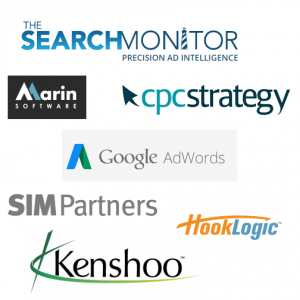2016 Search Predictions from Leading Industry Experts

As we approach 2016, retailers and ecommerce professionals across the globe are re-evaluating their online marketing strategy.
From technology to branding and user preferences – it’s a challenge to digest the many ongoing and exciting changes emerging within the search ecosystem. 
If retailers and marketers want to stay ahead of their competitors, it’s essential to educate yourself on the latest trends and best practices leading into 2016.
So, what do the experts predict?
We asked a panel of leading search experts to answer the top questions on every retailer’s mind:
 Kelly Wrather is the Senior Manager of Content Marketing at Kenshoo. Prior to joining Kenshoo, she helped launch the Accuen brand, the trading desk of Omnicom Media Group. A graduate of Boston University’s College of Communication, Wrather’s previous experience also spans social media and online community management.
Kelly Wrather is the Senior Manager of Content Marketing at Kenshoo. Prior to joining Kenshoo, she helped launch the Accuen brand, the trading desk of Omnicom Media Group. A graduate of Boston University’s College of Communication, Wrather’s previous experience also spans social media and online community management.
A key trend to watch heading into 2016 is a greater emphasis on audience-based buying.
The emergence of Google Customer Match and remarketing in Bing Ads points to a move toward more audience data application to improve relevancy. Paid search already enjoys an explicit level of intent and layering audience targeting over that hopes to improve the user experience further.
Additionally, we are seeing Google looking to expand and automate the “long tail” of searches across several domains — dynamic search ads is but one example of this. By looking across a broader base of searches with audience targeting, consumers are more likely to see the right message at the right time, creating “premium” search inventory that doesn’t exist today.
Moving into 2016, retailers should be focused on how to create a more personalized experience for shoppers, ensuring they are present at the key inflection points. With this comes a serious investment in mobile. Early 2015 holiday shopping season data from Kenshoo revealed that half of all retail search clicks on Thanksgiving and Black Friday were on a smartphone.
As consumer behavior continues to shift, retailers must adjust strategies accordingly by helping to create a better overall mobile experience. This requires not just a presence on mobile search but assurance that the post-click experience is well optimized to encourage conversion.
Furthermore, retailers need to take the holistic view in cases where purchases start in one place (for example, PLAs on mobile) and end elsewhere (brand searches on desktop). Technology will continue to innovate and improve so retailers have a more holistic view of their customers across channels, online and offline, and devices to really understand the path to purchase.
There’s a saying “if it ain’t broke, don’t fix it.” I would encourage mature marketers who think their tried-and-true campaigns and methods are delivering just fine to consider how even slight tweaks and changes may impact performance.
Perhaps that means restructuring accounts; testing new keywords, calls to action, or landing pages; exploring new formats. Constantly look for new opportunities for incremental growth and embrace a “test-and-learn” approach.
 Emily brings nearly 10 years of digital marketing expertise with experience in both product marketing and client services. Prior to joining SIM Partners, Emily helped establish the product marketing discipline at Kenshoo after learning the product as an account director. Emily holds a BA in psychology from Washington & Lee University.
Emily brings nearly 10 years of digital marketing expertise with experience in both product marketing and client services. Prior to joining SIM Partners, Emily helped establish the product marketing discipline at Kenshoo after learning the product as an account director. Emily holds a BA in psychology from Washington & Lee University.
Near me searches (i.e. “tacos near me”) nearly doubled in 2015, likely due to the rise of mobile, and I expect this trend to continue. These searches have become increasingly competitive, especially since Google decreased the number of local map results displayed in SERPs from seven to three and ad blockers are growing in popularity.
As a result, I believe brands will begin to place more value in their location data and create strategies to optimize that data so they are present in the moments when and where consumers are searching.
While a majority of searches still happen on search engines, retailers should be thinking of the evolution of information discovery through things like IOS spotlight search, Facebook, Foursquare, etc.
For retailers with physical locations, they should pursue location data management so their stores can be discovered wherever people are searching–whether it’s search engines, their GPS system in their car, or a IOS spotlight search. Being found is just the first step though.
By creating contextual content and compelling offers tied to mobile wallets and/or beacons they will be able to turn consumers into customers.
If you’re a multi-location brand, don’t overlook your location data. This is a huge asset that helps you be found and be contextually relevant to consumers so can you move them towards that next moment of conversion.
Although ecommerce has grown, in store sales continued to rise in 2015- suggesting that people researched online but still bought in stores.
If you are able to reach consumers when they are near your physical locations, provide them directions, and show them a compelling offer you’ll have a leg up on your competition.
 Lewis Brannon manages retail-focused digital ad campaigns (Paid Search / Search Engine Marketing (SEM/PPC), Internet Marketing, Online Advertising, Search Marketing) for various clients across a diverse group of verticals.
Lewis Brannon manages retail-focused digital ad campaigns (Paid Search / Search Engine Marketing (SEM/PPC), Internet Marketing, Online Advertising, Search Marketing) for various clients across a diverse group of verticals.
At CPC Strateg,y his focus has been on growing and improving the Search Marketing Department through standardization of operating procedures, initiatives to improve scale ability, reporting & analytics tool creation and testing, bid automation product development, and cultivation of client services.
Growth of dynamic search and the meshing of paid and organic search algorithms by Google to better target the 15% of unique, never seen before searches on Google that are done every day.
This will be especially important for large e-commerce sites with rapidly changing content/products, allowing them to better target the long-tail queries and improve landing page relevancy, while also putting an onus on site architects to continuously improve the quality of their site infrastructure.
Google Shopping and product listing-type ad formats should continue to grow in importance and effectiveness. Google AdWords, BingAds, and Yahoo Gemini all now offer a product listing type of ad format, and Google continues to experiment with new placements of their Shopping units (YouTube, Google Images). So, we will see advertisers continue to shift more budgets into this campaign type.
Focusing on the structure of their search campaigns and ensuring that money is not being wasted on poorly built and non-optimized campaigns. In order to get to a growth stage, advertisers must first pare-down their PPC efforts into a format and structure that allows for agile bid and budget allocations and is conducive with campaign experiments.
Once a sound architecture is in place, there are many opportunities to grow, among which are Google Shopping, Dynamic Search, YouTube Search campaigns.
Think long term about where search is going.
The signs point to less emphasis on traditional keyword buying and text ad writing and more emphasis on structured data-based advertising, including Shopping and Dynamic Text, Structured ad snippets, dynamic add-ons, and “time and place” ad serving.
These factors indicate the importance of focusing primarily on the quality of your web design / information architecture. Advertisers that excel in that area will be in the best position to experience success in the new age of search.
 Jonathan Opdyke co-founded HookLogic in 2004 on the idea that marketing closer to consumer decision points would not only be more effective for marketers, but also more useful for consumers.
Jonathan Opdyke co-founded HookLogic in 2004 on the idea that marketing closer to consumer decision points would not only be more effective for marketers, but also more useful for consumers.
Under his leadership, HookLogic has grown from a boot-strap start-up to a global enterprise powering integrated native advertising programs across many of the internet’s most recognized ecommerce sites. As an early advocate of ecommerce media, Jonathan helped make the practice of blending digital advertising sales with traditional commerce models standard among many online retailers and travel agencies.
When we look at consumer trends, the growth of mobile usage is certainly one of the biggest.
In 2015, mobile surpassed desktop for Google searches worldwide. At HookLogic, we saw mobile ecommerce traffic overtake desktop for the first time during the fourth quarter of 2015. 2016 will see even more mobile growth as people recognize the convenience of using these devices to access product information and participate in mobile commerce.
From a marketer’s perspective, search capabilities will go far beyond Google, Bing, and Yahoo and branch out to ‘vertical search’ on social oriented sites like Facebook, Twitter and Yelp, as well as ecommerce sites like Amazon, Walmart, and Expedia.
As consumers consider the best source of a certain type of information, it’s increasingly common for users to skip search engines altogether and conduct their specific searches within vertical or topical sites.
For advertisers, the rise of vertical search engines gives them more options, enabling them to better target ads and measure ROI in new ways.
For example, a CPG brand is better off placing an ad for its products on the search results within Walmart.com, Target.com and Peapod.com where user intent is clearer and transactional outcomes can be measured than it is placing an ad on Google that steers users to its own brand website where users can’t transact.
There are two ways of looking at this, depending on if the retailer is a ‘mass merchant’ like Target, or if it is a ‘brand.com’ like Huggies.
For mass merchants, leveraging Google Product Listing Ads and AdWords are tried and true ways to compete with other mass merchant retailers and drive more business.
Search can also be a monetization opportunity for these companies, by creating on-site search advertising opportunities for the brands they sell. This is what we offer at HookLogic, enabling a new revenue stream for retailers, while at the same time keeping the consumer on the retailer site with click in native ads.
For brands, these on-site search opportunities are much more valuable than Google, and should be a key focus in 2016. Traditional search marketing is often ineffective for brands, because they’re essentially competing against their retail channels for prime keywords, while driving traffic to non-transactional brands sites.
The first priority should always be evaluating your search engine optimization and making inexpensive improvements to take advantage of organic search placement on any platforms that are important to the advertiser.
Inevitably, there will still be incremental opportunity available from paid search. I would also advise that advertisers look beyond Google to emerging vertical search opportunities that may serve their business better or at least in complementary ways to Google.
What’s important is that advertisers keep their eye on the prize – sales performance. Any search advertising should be driving incremental sales at an acceptable ROI, otherwise there’s not much point.
 Dan Morris has more than 10 years of experience in the digital advertising field helping companies build their brands and acquire new customers. Currently, as Director of Product Marketing at Marin Software, his team is responsible marketing company’s Audience Marketing Suite of search, social and display advertising products on a global scale.
Dan Morris has more than 10 years of experience in the digital advertising field helping companies build their brands and acquire new customers. Currently, as Director of Product Marketing at Marin Software, his team is responsible marketing company’s Audience Marketing Suite of search, social and display advertising products on a global scale.
The focus of cross-device to cross-everywhere – Over the past several years, consumers have shifted towards using multiple devices in their buying process along the path to conversion, creating a complex, fragmented environment for retail advertisers trying to reach customers with strong purchase intent. As an industry, we’ve gotten better at tackling this problem through deterministic and probabilistic matching across devices.
With the proliferation of connected devices (commonly referred to as the “Internet of Things”) the opportunities for understanding customer needs and intentions though signals captured on ever day devices will become increasingly prevalent for retail advertisers.
Imagine a world where we can understand when a customer is in need of a new household cleaning product or has an issue with an electronics product based on signals we can ascertain from the products themselves.
Retail advertisers will be able to fulfill this demand immediately without the customer lifting a finger. This is the way the industry is moving, and the way that consumer purchase behavior is trending – Going beyond cross-device marketing and thinking more along the lines of “cross-everywhere” in terms of how we understand and engage audiences.
However along with the benefits of the growth and advancements of connected devices come challenges as well.
How will retail advertisers aggregate, analyze and utilize the universe of customer intent signals that are amassed through the IoT?
The advertisers that invest in technology focused on solving these problems today will ultimately be the ones getting a leg up on the competition down the road as this type of marketing becomes more commonplace.
 Jostin Munar is a driven team leader for CPC Strategy’s Google Shopping Specialists within their Account Management department. He specializes in product development and client services across search and social platforms.
Jostin Munar is a driven team leader for CPC Strategy’s Google Shopping Specialists within their Account Management department. He specializes in product development and client services across search and social platforms.
I agree that retargeting, Customer Match, and audience building will continue to shape search in 2016.
If you’re not dialed in with your current customer base (pricing, offers, etc) – it’s going to be tough to grow in 2016. Retailers are definitely going to have to re-engage.
This past year, social – thanks to Facebook Product Ads and Instagram, is now providing much more in terms of paid advertising, so I expect many retailers are going to continue to move towards that.
In terms of the reaction to ads, millennials are a bit more in tune with what is an ad vs. what is not an ad. Before, many ads had a negative connotation. (For example, “Oh, if I click on this ad, I’m going to get a virus”.)
Now, we know click on ads are not harmful and that ads can help customers see more of the content that they want. For example, if I click on a Nike product ad – it’s likely I’m going to be much more inclined to accept Nike ads in the future.
So, how can businesses tailor to that?
Retailers should definitely focus on audience building and tailor their social presence, making sure their products are in all the right types of product ads. Retailers / marketers should research the right time frame of effective dynamic product ads vs static ads.
My tip, is to be really dialed in your promotions (don’t run the same promotions for more than 6 months for example) and learn to engage based on those types of posts.
Feed quality for Google Product Ads – Google is moving towards developing better systems on the Merchant side of things.
For example, in the GMC they’ve started to show messages that are actually going out to each of the clients (housing it all within GMC). Also, the feed re-approval process is being improved. If this is an emphasis on Google’s side then hopefully this should be a trend spread to others as well.
For mature businesses, social is going to help them grow (especially on the customer service side).
If they can go and interact appropriately with people on all these social networks (on their Google+ page, through reviews, etc.) it’s going to bring them to the forefront. Customers are going to be more trustworthy of them.
That’s why Amazon is so successful, because they have those customer reviews. That is why a random seller can join Amazon – build up a lot of reviews and dominate the Marketplace. If businesses can mimic that same structure or experience on their own page – they are going to continue to build a customer base.
 Jason Bell is the leading Senior Account Analyst at CPC Strategy with over 6 years of SEM experience. He’s managed a number of high profile clients including Sears, Riddell, ABT and Deluxe.
Jason Bell is the leading Senior Account Analyst at CPC Strategy with over 6 years of SEM experience. He’s managed a number of high profile clients including Sears, Riddell, ABT and Deluxe.
I definitely think remarketing is going to continue to be very important.
Google specifically, (Bing will follow) – adding more and more ways for you to remarket to the customer because we know typically (depending on how your build out your audiences) that your conversion rates are going to be higher and your click through rate is probably pretty good. So it’s really an opportunity to get back in touch with those customers who already know who you are as a brand.
I think Customer Match and RLSAs for Shopping will continue to trend.
I also think that Shopping is going to continue to grow until a marketplace eventually sprouts, which is obviously what we all think it’s pointing to. We can’t say that’s officially happening, of course. Same goes for social media, which will continue to grow because it allows you to put an image to your brand and messaging across platforms.
For search specifically, businesses need to focus more on being able to create a full experience – through some of those channels (ex: social media, Google Shopping, Text Ads) and really show off their brand for each sale.
Obviously, this won’t work for everyone – it will depend on what you are selling and what the market is like. Rich content is becoming more and more important outside of just the paid realm.
From a paid search point of view – focus on not being so broad. Find out what your money content is (keywords and key terms) and build around that. Retailers should focus on where they can win, rather than always casting a wide net. If you can find areas where you are winning – dominate those areas even further and refine areas where you have opportunity first.
 Ken barber has more than 12 years of experience creating & executing sales-focused digital marketing plans for ad agencies, start-ups, and tech companies. As VP of Marketing, Barber specializes in lead generation, client marketing, and campaign measurement and optimization.
Ken barber has more than 12 years of experience creating & executing sales-focused digital marketing plans for ad agencies, start-ups, and tech companies. As VP of Marketing, Barber specializes in lead generation, client marketing, and campaign measurement and optimization.
The Search Monitor helps advertisers and their agencies better understand online advertising so they can improve campaign performance and attract new customers.
Local search will continue to shape search marketing in 2016.
Marketers need to better understand the local search strategies used by competitors for their keywords. They must know, for example, which local markets they are in, how much visibility they achieve in these markets, and how they adjust messaging/offers/landing pages down to the city level.
Mobile search will join local as the other 2016 focus for search marketers.
While a desktop strategy may work for some mobile users, marketers need to constantly test different keywords, offers, and landing pages to find the combination that works for a more distracted, location-aware consumer.
Retailers need to take advantage of the more eye-catching elements on the search results page in 2016. These include Ad Extensions and Product Listing Ads, and probably a bunch more that Google will roll out as the year progresses.
Retailers should also experiment more with retargeting ads that catch consumers at the right time in their shopping process, with the right message. They need to navigate that fine line of being helpful (i.e., linking them back to a product they were searching for), and creepy (i.e. “Come back and finish purchasing your underwear!”)
With the basic campaign set-up and optimization out of the way, mature search marketers need to focus on learning from competitors and industry leaders. Imitation is the sincerest form of flattery!
Automated web crawling technology can now deliver real-time, detailed reports on an advertiser’s most popular offers and promo codes, and even when they increase and decrease their paid ad market share throughout the year. When established marketers see the exact moves made by other advertisers on their keywords, they can more easily identify opportunities to stay competitive as well as gain share.
